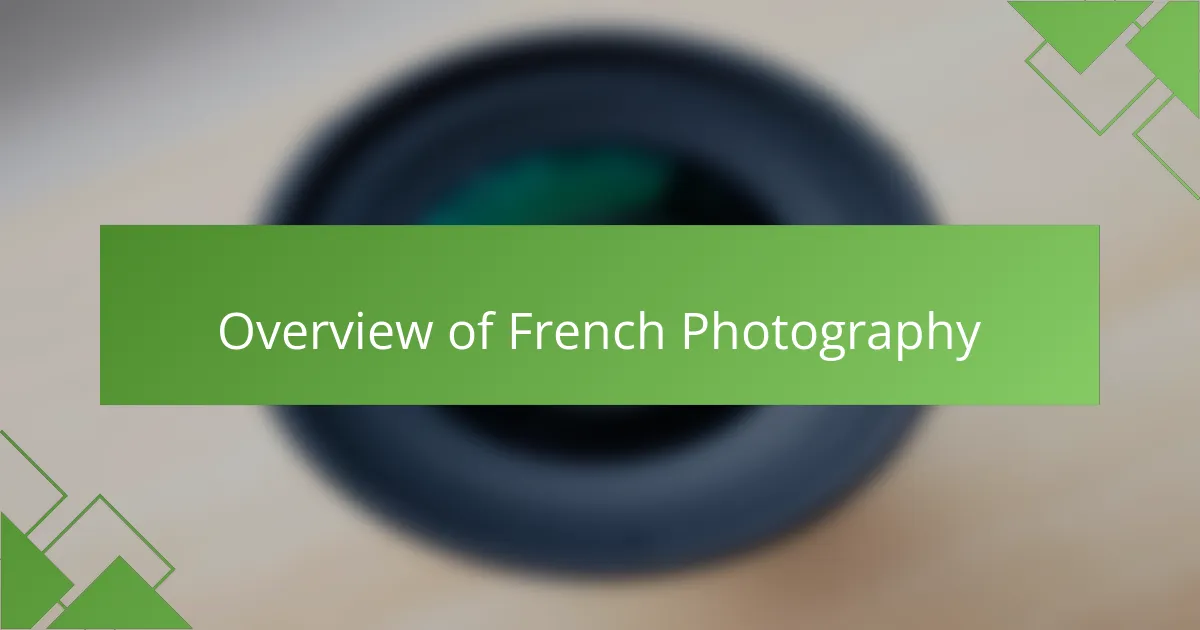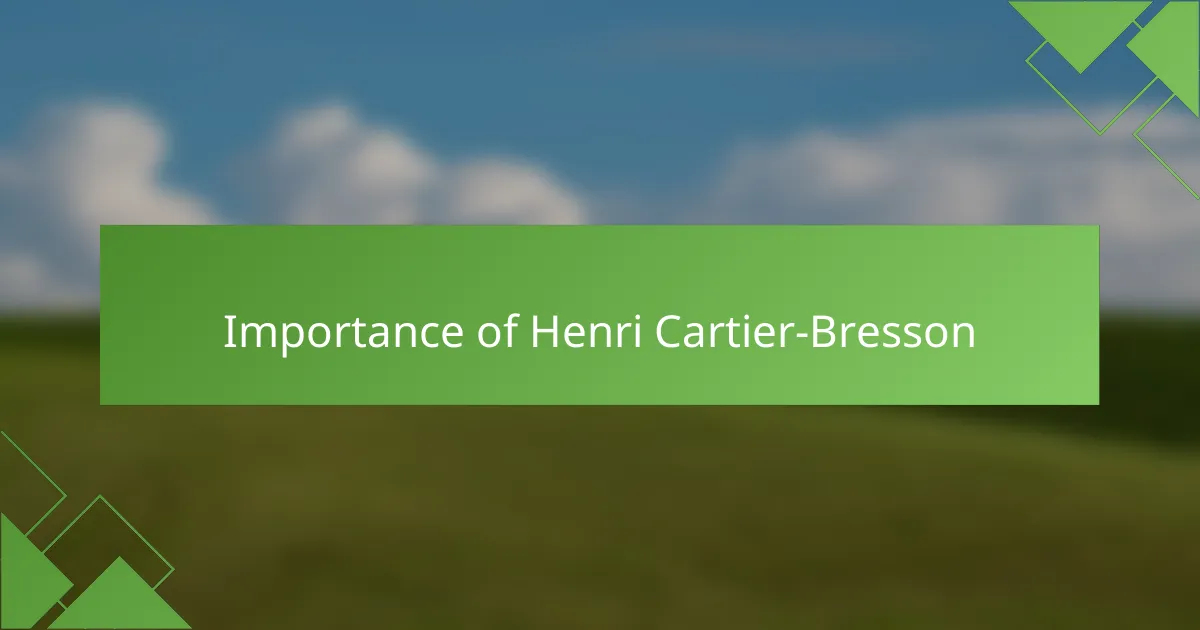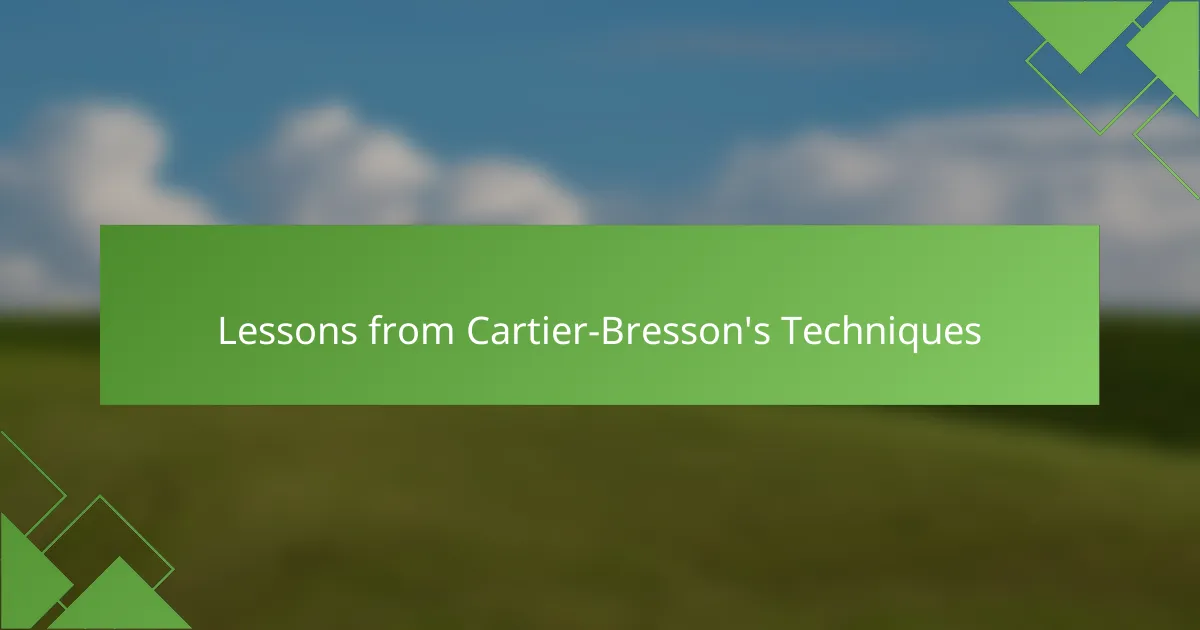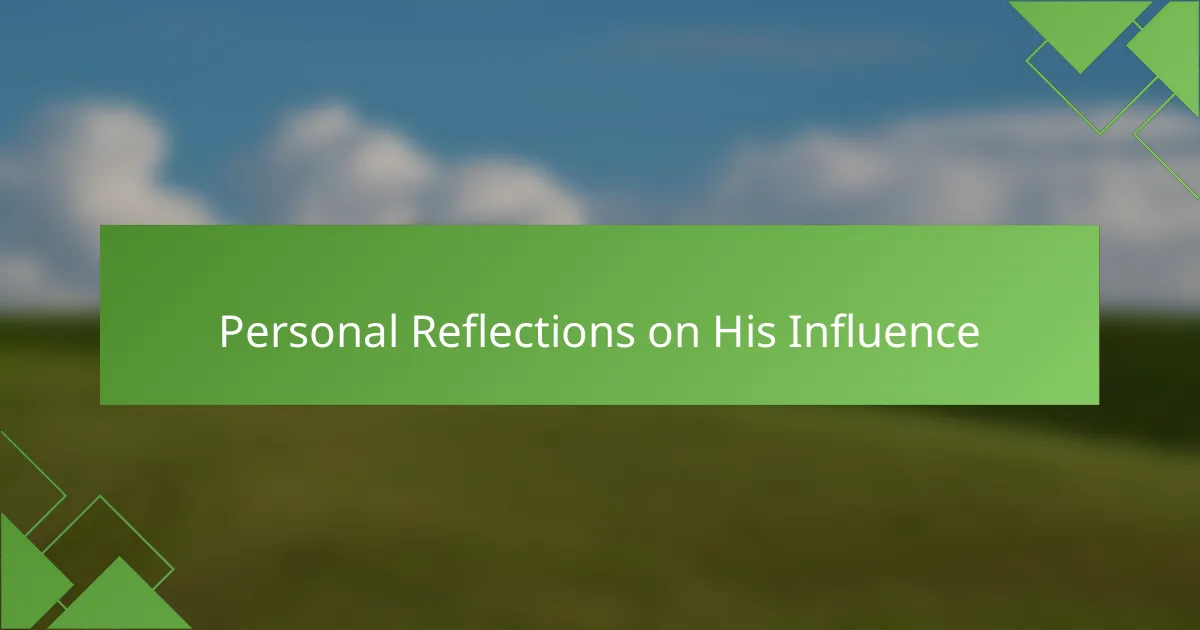Key takeaways
- French photography uniquely combines artistry and storytelling, with a significant cultural context.
- Henri Cartier-Bresson’s “decisive moment” concept emphasized capturing fleeting instants that reveal deeper truths about life.
- His techniques in composition and focus on candid moments inspire photographers to find beauty in everyday interactions.
- Cartier-Bresson’s work encourages a present and engaged approach to photography, transforming ordinary scenes into extraordinary narratives.

Overview of French Photography
French photography has always held a unique place in the world, steeped in a rich history that combines artistry with a profound sense of storytelling. When I think about the iconic works of photographers like Henri Cartier-Bresson, I can’t help but feel that there’s an undeniable magic in the way they capture fleeting moments and elevate the mundane into the extraordinary. Have you ever experienced that rush of emotion when a photograph speaks to you? That’s what the best French photography often accomplishes.
As I delve deeper into the world of French photography, I realize it’s not just about the images; it’s about the cultural context and the photographer’s perspective. Through the lens of artists like Robert Doisneau or Brassaï, we see Paris not just as a city but as a living, breathing character in their stories. The ability to convey the subtleties of everyday life through a single frame is a hallmark of this genre.
Moreover, the influence of French photography goes beyond borders, inspiring photographers worldwide to explore their own environments in meaningful ways. It’s fascinating to ponder how the techniques and philosophies of these French pioneers continue to resonate today. Their work challenges us to reflect: What moments in our daily lives deserve to be captured and shared?

Importance of Henri Cartier-Bresson
Henri Cartier-Bresson is often hailed as the father of modern photojournalism, and it’s easy to understand why. His concept of the “decisive moment”—the perfectly timed split second that reveals the essence of a scene—has deeply influenced how I perceive photography. Whenever I hold a camera, I strive to find my own decisive moments, just as he did, reminding me that storytelling is always present, waiting to be captured.
What I find particularly important about Cartier-Bresson’s work is his exceptional ability to blend art with journalism. He didn’t simply document life; he made it poetic. His images evoke feelings and thoughts that transport us to another time and place, encouraging viewers to reflect on their surroundings. Have you ever looked at a photo and felt an overwhelming sense of nostalgia? That’s the power of Cartier-Bresson’s art.
Moreover, his approach has had a lasting impact on both amateur and professional photographers, inspiring them to explore candid photography. I remember the first time I tried to emulate his style during a street photography session—it was challenging but exhilarating. Cartier-Bresson taught me that the world is teeming with stories, and all we need to do is pay attention to the moments unfolding before us.

Key Characteristics of His Work
Henri Cartier-Bresson is often celebrated for his keen ability to capture the decisive moment. This concept, which I find incredibly powerful, expresses the idea that a fleeting instant can reveal a deeper truth about life. His work often conveys a spontaneity and authenticity that resonate with emotional depth, making viewers feel an intimate connection to the scenes he immortalized.
Another notable characteristic is his unique composition, where geometry plays a crucial role. I remember being struck by how he used lines and shapes to draw the eye into the photograph, creating a balance that felt effortless yet meticulously planned. His black-and-white images always seemed to evoke a timeless quality, allowing me to see the beauty in everyday moments and urging me to look closer at my surroundings.
Cartier-Bresson’s emphasis on candid photography, rather than posed portraits, makes his work feel genuine and unfiltered. When I examine his frames, I often feel that I am witnessing a private moment, a slice of life that had been unguarded and real. This approach not only speaks to his technical skill but also to his profound understanding of human emotion.
| Characteristic | Description |
|---|---|
| Decisive Moment | Capturing fleeting instants that reveal deeper truths about life. |
| Composition | Masterful use of geometry and balance to enhance visual storytelling. |
| Candid Photography | Focus on unposed moments to convey authenticity and emotional depth. |

Lessons from Cartier-Bresson’s Techniques
I have learned so much from Henri Cartier-Bresson’s techniques, especially when it comes to the “decisive moment.” I remember my own thrill while waiting for the right second to press the shutter. It was exhilarating, as if the world suddenly paused, allowing me to capture something truly special. Have you ever felt that anticipation? There’s a magic in being present and aware, which is what Cartier-Bresson mastered so effortlessly.
Another lesson that stands out to me is his approach to composition. I often find myself experimenting with geometry in my own photos, inspired by his use of lines and shapes to create balance and intrigue. It’s fascinating how a slight adjustment in framing can completely transform the story a photo tells. When I apply this technique, I notice that my images carry a sense of artistry that I hadn’t been able to achieve before.
Lastly, his focus on candid moments resonates deeply with me. I’ve always felt that unguarded emotions tell the most powerful stories. I recall a day spent photographing people in a bustling market, capturing their genuine interactions. It was a reminder that the rawness of life often holds the most profound beauty. Cartier-Bresson taught me to embrace the unpredictable nature of life, and I cherish those spontaneous moments that reveal the essence of our shared experiences.

My Journey with His Portfolio
My journey with Henri Cartier-Bresson’s portfolio has been nothing short of transformative. The first time I stumbled upon his iconic photograph, “Behind the Gare Saint-Lazare,” I felt an immediate connection. The way he captured the decisive moment struck a chord in me—it’s as if I could feel the cold air and the rush of the scene right through the image.
As I delved deeper into his work, I found myself reflecting on my own approach to photography. I realized that it’s not just about pressing the shutter at the right time; it’s about understanding the story behind each frame. This revelation inspired me to embrace spontaneity in my own projects, allowing moments to unfold naturally.
- Discovering the concept of the “decisive moment” changed my perspective on composition.
- Each photograph in his portfolio evokes a rich narrative that transcends time and space.
- I felt a wave of inspiration after analyzing how he used light and shadow to create emotion.
- Viewing his work reminded me to be more observant of everyday life, capturing the beauty in the mundane.
- Henri’s ability to evoke emotion through candid moments has prompted me to seek authenticity in my own work.

Personal Reflections on His Influence
Henri Cartier-Bresson’s influence on my photography journey resonates deeply within me. I vividly recall the first time I tried to emulate his ‘decisive moment’ philosophy at a crowded street festival. With my camera poised, I felt a rising tension in the atmosphere—would I capture something as powerful as he did? That moment taught me to appreciate the art of anticipation, embracing the chaotic beauty of life unfolding around me.
One aspect of Cartier-Bresson’s work that always captivates me is how he showed us that the ordinary can be extraordinary. I remember walking through a local market, inspired by his ability to find narratives in everyday scenes. I slowed my pace, observing the interactions and gestures of people, realizing that every glance and movement could tell a story. It was a revelation that changed how I approached my surroundings, pushing me to be more present and engaged with life.
Reflecting on his photos, I often wonder how he managed to evoke such profound emotions with just a single frame. One memorable evening, as I analyzed his work, I felt a sense of nostalgia wash over me—each image transported me to its moment in history. This emotional connection drives me to infuse my own work with a similar depth, reminding me that the heart of photography lies in capturing the authentic feelings we experience in fleeting moments. What stories might my lens tell if I only open my eyes a bit wider?